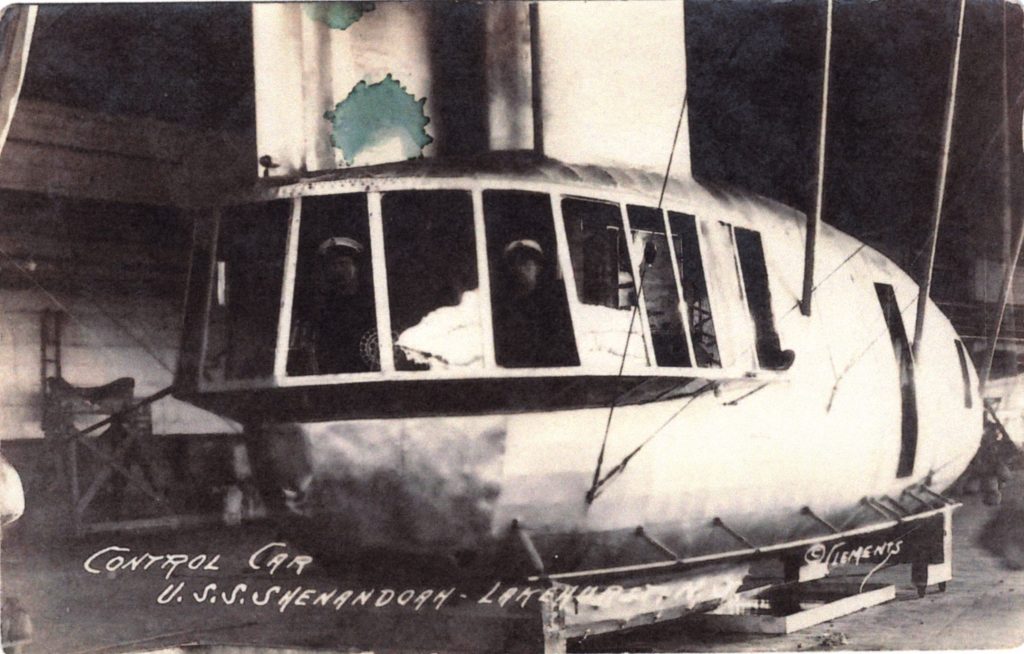I have always been interested in United States Navy related subjects on postcards, so I was pleased to find these three ANZO, real photo postcards for sale online. They cover a less often explored side of naval history that dates from 1918 to 1930.

U.S.S. Shenandoah was the first of four rigid air ships operated by the U.S. Navy after World War I. These lighter than air ships were held aloft by gases that were less dense than the surrounding air, typically hydrogen or helium. Hydrogen was, at the time, much easier to obtain but was extremely flammable. Only a limited supply of the non-flammable helium was available in 1923, but after the fiery crash of the U.S. Army’s airship Roma in 1922, the U.S. government made the decision to use only helium in future lighter than aircraft.
U.S.S. Shenandoah’s skeletal structure was assembled at the U.S. Navy’s Lakehurst Naval Air Station in New Jersey from 1922 through 1923. Her rigid structure was made from a very strong but lightweight alloy of aluminum and copper known as duralumin. All the metal pieces used in her construction were manufactured by the Aluminum Company of America (Alcoa) and finally machined at the Naval Aircraft Factory in Philadelphia, Pennsylvania. The parts were then sent to Lakehurst’s huge airship hanger for assembly.

Although Shenandoah was not the first rigid airship, she was the first to be built and commissioned in the United States. In 1900, Count Ferdinand von Zeppelin (1838-1917), an officer in the German Army who had an interest in balloons for both military and transportation, built and commanded the first rigid airship, the LZ1. Von Zeppelin was the driving force behind the development of all these magnificent machines which stayed popular long after his death.
Following Shenandoah’s frame assembly, crews began loading helium filled bags into key sections of the frame. Each bag was made from goldbeater’s skin (the outer layer of a cow’s intestine) cemented onto cotton fabric and varnished.
The final step in Shenandoah’s construction consisted in covering her surface with hundreds of yards of cotton fabric and a celluloid-based resin, called dope. A final layer of dope mixed with powdered aluminum was applied to provide her with a waterproof exterior and allowing her to reflect sunlight.
On September 4, 1923, after the engines and control car were added, the lighter than airship took flight for the first time. On October 10, 1923, the originally named ZR 1 was officially christened at Naval Air Station, Lakehurst, New Jersey as U.S.S. Shenandoah by Marion Bartlett Thurber. Thurber was the wife of then Secretary of the Navy Edwin Denby, who served during the Harding administration.

On October 7, 1924, U.S.S. Shenandoah under the command of Lieutenant Commander Zachary Lansdowne, left Lakehurst, New Jersey for a cross-country flight. She flew to air ship moorings in San Diego, California, and Tacoma, Washington, before returning to Lakehurst on October 26, 1924. This 19-day flight was the first transcontinental flight of a rigid airship.
From then until September 2, 1925, Shenandoah performed various U.S. Navy missions. On that date, she left Lakehurst, New Jersey, on a flight to Caldwell, Ohio. The flight was to be the start of another cross-country flight but sadly ended up being her last.
On September 3, 1925, Shenandoah suddenly encountered an area of extreme air currents driven by stormy weather. Within thirty minutes, the force of these air currents caused her structure to break apart. The control car broke away and fell to the ground killing Lansdown and several members of the crew who were working to save the ship.
Of the 43 crewmen and officers on board, 14 members of Shenandoah’s crew were lost that day. There is a memorial site, near Ava, Ohio, dedicated to the memory of those serving aboard this pioneering airship.
_________________
The first four rigid airships operated by the U.S. Navy were: U.S.S. Shenandoah (ZR-1): The first American-built rigid airship; U.S.S. Los Angeles (ZR-3), originally built by Germany as LZ 126, later acquired by the U.S. Navy; U.S.S. Akron (ZRS-4), sister ship to the Macon; and U.S.S. Macon (ZRS-5), sister ship to the Akron.
The Lakehurst Naval Air Station was also the site of the Hindenburg disaster, which in 1937 basically brought the era of rigid airship travel to an end.
Thank you very much for the interesting article!
Thanks for the interesting information about these lighter-than-air Navel air ships; they make an interesting category in postcard collecting. Enjoyed this article.
I am a local journalist who writes a history column. The Shenadoah flew over Orange, ma.
Athol Daily News – A Page from North Quabbin History: The Shenandoah
Great article. I really enjoy discovering old airship postcards.